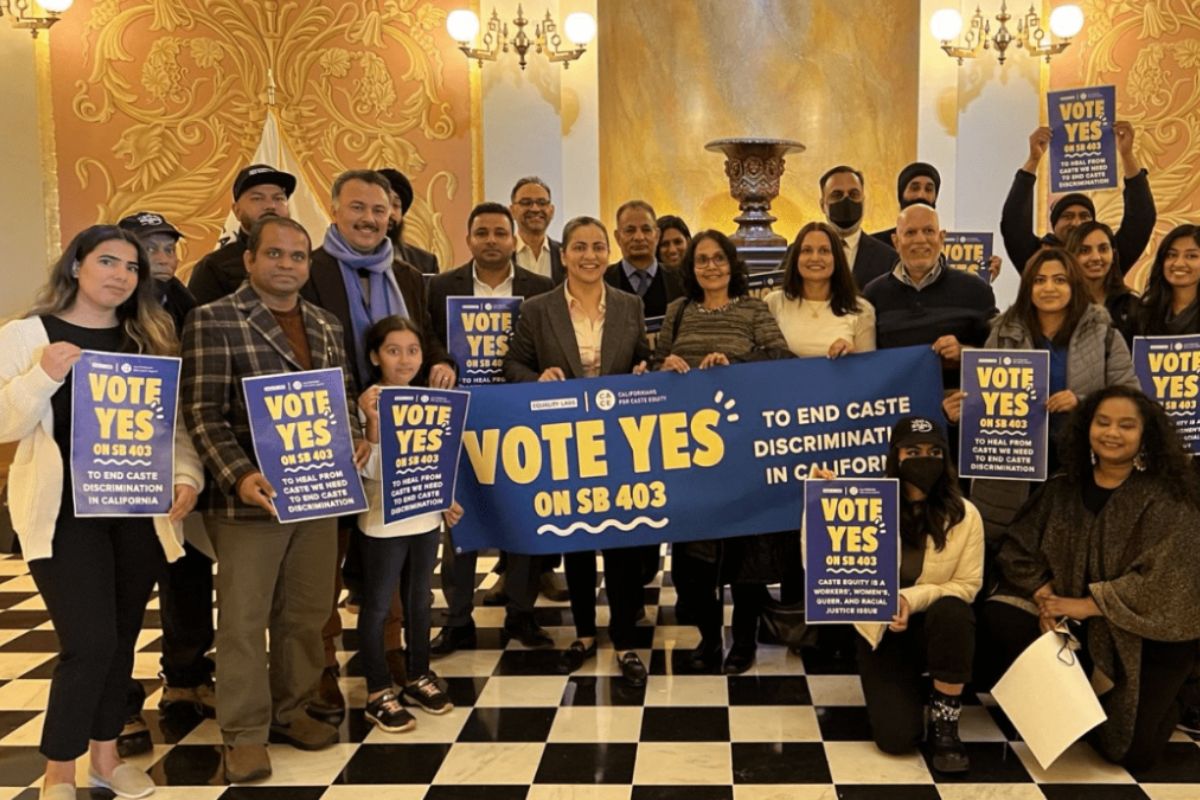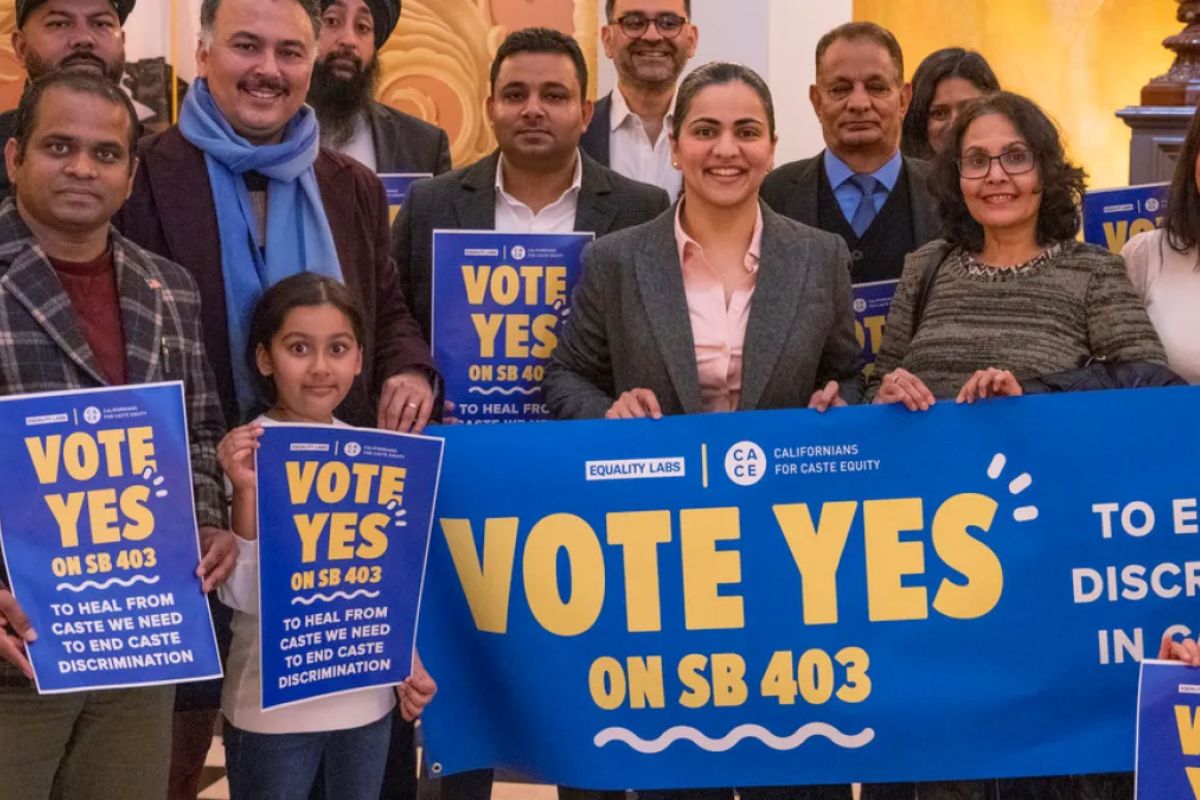SB 403 California Stand Against: Imagine if the shadows of your ancestry dictated your opportunities today.
In California, SB 403 aims to shed light on the insidious nature of caste discrimination.
As the bill navigates through the legislative process, it unearths uncomfortable truths about societal hierarchies.
Stay tuned to discover how this legislation challenges deeply ingrained biases and the repercussions it might have on a global scale.
Key Takeaways
- SB 403 combats caste discrimination in California.
- Addresses educational and employment barriers for Dalits.
- Sparks debate on societal divisions and discrimination.
- California sets a global precedent against caste-based biases.
The Birth of SB 403
The inception of SB 403 marks a pivotal moment in California’s legislative history, heralding a bold step towards combating caste discrimination within the state. State Senator Aisha Wahab authored bill, SB 403, emerged as a beacon of hope for those marginalized due to their caste identity. This groundbreaking legislative endeavor sought to include caste as a protected category under anti-discrimination laws, a move that was long overdue in addressing the systemic biases faced by Dalits and other marginalized communities.
With overwhelming support reflected in the resounding majority of 34-1 votes, SB 403 underscored the urgent need to address the insidious nature of caste discrimination within California. The passage of this bill not only signified a triumph for those advocating for social justice but also highlighted the state’s commitment to upholding the rights and dignity of all its residents, regardless of caste background.
SB 403’s journey from inception to enactment serves as a testament to California’s unwavering dedication to combating discrimination in all its forms, setting a powerful precedent for other states to follow suit in the fight against caste-based prejudices.
Casteism’s Hidden Impact
Amidst the vibrant cultural tapestry of California, the insidious impact of casteism silently pervades, affecting the lives of Dalits and other marginalized communities in profound ways. Despite physical distance from South Asia, Dalits in California grapple with the enduring prejudices of the Indian caste system. SB 403 takes center stage as a response to the hidden reality of caste discrimination, addressing the struggles faced by a significant portion of California’s South Asian population, including over 1 million residents.
- Generational Trauma: Caste discrimination perpetuates intergenerational trauma, impacting mental health and well-being.
- Educational Barriers: Dalit students often face discrimination in educational settings, hindering their academic success.
- Employment Inequality: Caste-based biases affect job opportunities and contribute to economic disparities.
- Social Exclusion: Casteism leads to social exclusion, limiting access to resources and community support.
The hidden impact of casteism in California underscores the urgent need for measures like SB 403 to combat discrimination and foster a more inclusive society.
The Debate Unveiled
Caste discrimination in California has sparked a contentious debate surrounding the necessity of SB 403, with supporters and critics clashing over its implications for combating systemic biases. While proponents of the bill argue that it’s a crucial step towards addressing the deep-rooted issue of caste-based discrimination, opponents contend that existing laws are adequate and that SB 403 might exacerbate societal divisions.
Supporters emphasize the need to protect individuals born into lower castes from discrimination and believe that SB 403 is a critical tool in achieving this goal. They argue that without specific legislation addressing caste discrimination, marginalized communities will continue to face unequal treatment and limited opportunities.
On the other hand, critics raise concerns about the potential unintended consequences of the bill, suggesting that it could create more discord than harmony within society. They question whether SB 403 is the most effective means of combating caste discrimination and advocate for alternative approaches to address systemic biases. The debate surrounding SB 403 reflects the complex and multifaceted nature of caste discrimination in California, highlighting the challenges and differing perspectives in the ongoing fight for equality.
Dalits’ Fight for Equality
In the ongoing battle for equality and justice, Dalits in California stand resilient, seeking recognition and empowerment through SB 403. This fight isn’t just about legislation; it’s a quest for dignity, respect, and the right to live free from the shadows of caste discrimination.
Here are key aspects of Dalits’ fight for equality:
- Historical Injustice: Dalits have endured generations of systemic oppression, marginalization, and violence based on their caste identity.
- Educational Empowerment: SB 403 aims to address disparities in education by acknowledging the unique challenges faced by Dalit students and providing support for their academic success.
- Workplace Equality: Dalits often face discrimination in the workplace, hindering their professional growth. SB 403 seeks to create avenues for fair employment opportunities and advancement.
- Community Solidarity: Through grassroots movements and advocacy, Dalits are building a network of support and solidarity to amplify their voices and push for lasting change.
As Dalits continue their fight for equality in California, the passage of SB 403 symbolizes a crucial step towards a more inclusive and just society.
Also Read: California Torrential Rains Fueling the Transmission of a Lethal Fungal Infection
California’s Global Impact
California’s Global Impact extends far beyond its borders, influencing millions worldwide as the state takes bold steps towards dismantling vestiges of the caste system through legislation like SB 403. By championing anti-discrimination laws, California sets a precedent for nations grappling with similar social injustices.
The ripple effects of SB 403 are felt globally, resonating with marginalized communities fighting caste-based discrimination. California’s stance not only elevates the voices of oppressed groups within its own boundaries but also serves as a beacon of hope for those facing similar challenges worldwide.
As the world watches California’s progressive actions, the state’s commitment to equality and social justice reverberates across continents, inspiring movements and policy changes in regions where caste discrimination persists. The impact of SB 403 transcends legislative boundaries, symbolizing a monumental shift towards a more inclusive society where every individual, regardless of their background, is afforded dignity, respect, and equal rights.
Conclusion Of SB 403 California Stand Against
SB 403 is a crucial step towards eradicating caste discrimination in California. By addressing this hidden form of oppression, the state is setting a powerful example for the rest of the world.
The fight for equality for Dalits is far from over, but this legislation marks a significant milestone in the ongoing battle against casteism. Let’s continue to stand together and advocate for a more just and equal society for all.
Our Reader’s Queries
What does SB 403 mean in California?
SB 403 aims to prohibit caste-based discrimination under the FEHA, Unruh Civil Rights Act, and California Education Code. Governor Newsom has until October 14, 2023, to officially endorse SB 403 into law.
What is the bill against caste discrimination in California?
Introduced by first-term Senator Aisha Wahab, a Fremont Democrat, Senate Bill 403 successfully cleared the Assembly with a 55-3 vote in late August and the Senate with a 31-5 vote in September. Senator Wahab secured support by making multiple amendments to the bill, notably incorporating caste as a subset of ancestry rather than a distinct category.
What is the act against caste discrimination?
India’s legal framework encompasses four key laws safeguarding citizens against caste-based discrimination. These include the Constitution of India, the Protection of Civil Rights Act, 1955 (PCRA), the Scheduled Castes and Scheduled Tribes (Prevention of Atrocities) Act, 1989 (PoA Act) along with its Rules, 1995, and the Prohibition of Employment Act.
How to remove caste discrimination?
The responsibility of panchayat members in combating caste discrimination involves initiating awareness campaigns. In instances of caste discrimination affecting adults or children within the village, these members should address the matter during the Gram Sabha, ensuring that the accused faces appropriate consequences.



